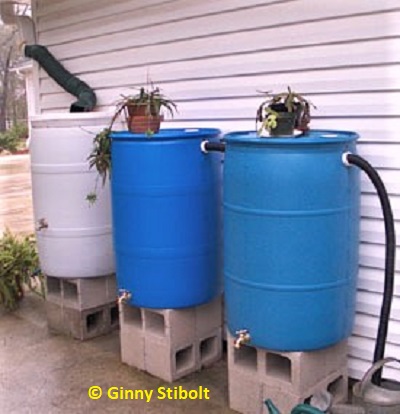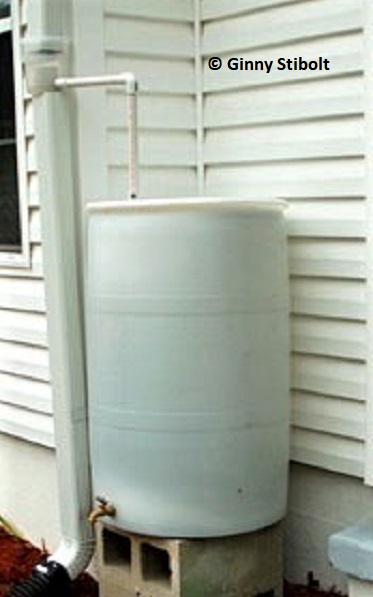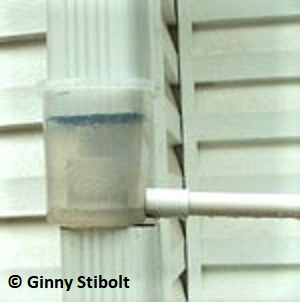|

Rain barrels next to Ginny's potting
bench
|
Climb
up my rain barrels
by Ginny Stibolt
Remember that old song that asked you
to: ďClimb up my rain barrel, Slide down my cellar door, And weíll
be jolly friends forever moreĒ? Well, you donít see those sloping
(or slidable) cellar doors in this part of the country and for a long
time, you didnít see rain barrels either, but thankfully thatís
beginning to change.
What can rain barrels do for you?
1) Provide free*, soft water**
for all of your inside and porch plants. Your plants will thank you.
During the dry fall months, I used rain barrel water to provide extra
water for all those trees I transplanted.
2) Provide a source of water in
areas that have no spigots. (Our three tandem rain barrels in the photo
are next to our potting bench at the spigot-less side of the detached
garage.)
3) Could save you money on your
water bill depending on how well you use your rainwater.
4) Slow down run-off into
streams and storm drains to reduce erosion, sedimentation, and
pollution. Environmentalists worry most about the initial surge of storm
water after a downpour because it causes the most erosion of the
previously dry soil and carries the most pollutants. Civil engineers
worry most about the initial surge because itís most likely to
overwhelm the storm water drainage system.
Forward-thinking towns and communities
encourage rain barrel use and some communities even provide discounted
rain barrels to their citizens. Just think how much the initial storm
water runoff would be reduced, if just half of a townís citizens used
a rain barrel or two.
Other ways to reduce runoff and
pollution from your property include installing rain gardens, reducing
the amount of lawn especially on sloping areas, and reducing the
fertilizer and poison applications to your lawn. Iím about to install
some rain gardens so watch for this adventure in an upcoming column.
* Freeóafter the initial cost of the
rain barrel(s).
** Some roofing materials have been
treated with chemicals to reduce moss growth or to preserve wood. Bird
droppings add to the mix, so rain barrel water is not for human
consumption.
Getting started
The easiest, but more expensive, method is to buy already configured
rain barrels and most of Florida's Agricultural
extension offices offer rain barrel workshops to help you get started.
But you can also make a rain barrel or a rain barrel system on your
own with a few common tools and a moderate amount of effort. Previous
experience working with PVC plumbing fixtures is helpful. The three
tandem barrels shown above include one barrel purchased in Maryland
and two my husband put together. 55-gallon barrels are often available
from bottling plants or food processing plants for free or for a small
fee.
You must make sure that the barrels have been used for food-grade
products. We were surprised to see the explosive and caustic warnings
on the syrup barrels, but the guy we talked to said that all soft
drink syrup is explosive and caustic. I knew there was a reason
why we donít drink the stuff. This is still a food grade barrel:
stay away from barrels used for poisons or petroleum products.
There are links to sites with specific instructions, lists of tools,
and everything you need to make a rain barrel below.
We have two separate rain barrel
systems:
1) The three tandem rain barrels next to the potting bench
have the downspout from the garage gutter emptying into the first
barrel, overflow hoses flowing into the other two barrels and a
final overflow hose emptying onto the driveway pavement. The first
barrel has a plastic catch-basket with a screen to filter out the
sticks and stuff from the roof and to reduce the risk of mosquito
eggs in the standing water.
The downspout originally just emptied all the water onto the pavement,
but now 165 gallons is stored in the barrels. In a good rainstorm all
the barrels fill up and the rest of the water runs into an area where
Iíve transplanted a water-loving Carolina willow (Salix caroliniana).
|

Closed rain barrel
system with no outflow.
|
2) The second system is a single, closed-system barrel near
our vegetable garden-to-be at the back of our house. The downspout
has been interrupted with a sacrificed (gasp!) Tupperware container
modified with PVC plumbing fittings that acts as a diverter. A pipe
to the barrel drains the container, but above the pipe opening is
collar that opens back into the downspout. When the barrel fills,
the container fills and the rest of the rainwater continues down
the downspout into the French drain system.
|

Overflow container
directs water back
into downspout .
|
This type of diverter is available for sale, if you donít have the
Tupperware to use. (Update: That plastic container
crumbled after a few years in the hot sun, so the next container was
the bottom of cranberry juice container.)
We could have added more rain barrels, but for now, these serve our
needs quite well, and with our rain gardens that further slow down and
absorb stormwater runoff, Iím happy with the minimal impact our household
will have on our pond, the lake, and eventually the St. Johns River.
(Update: see two more rain barrel articles Rain
Barrels Revisited and Three More Rain
Barrels)
Rain barrel resources:
- A Spouse's Guide to Building
the Perfect Rain Barrel System
- Arlington
Echo rain barrels
| 



